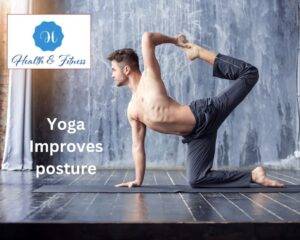Yoga Benefits for Men: Unleashing Strength, Flexibility, and Inner Peace
Discover the power of yoga benefits for men – unlocking strength, flexibility, and inner peace. Explore the advantages of a healthier you.
Introduction to Yoga Benefits for Men
Yoga offers many benefits for men, including increased flexibility, strength, balance, mental clarity, and more. In this comprehensive guide, traditionally viewed as a female-centric practice, Yoga has recently gained popularity among men. Despite the gendered stereotypes, the ancient discipline offers many benefits that cater to the unique needs of men. This blog post will explore the transformative power of Yoga for men, highlighting how it can enhance physical strength, flexibility, and inner peace, ultimately leading to a more balanced and fulfilling life.
We’ll explore nine key benefits of Yoga for men and provide a step-by-step approach to incorporating Yoga into your routine.
Top Yoga Benefits for Men
Yoga offers many benefits for men that go beyond the physical aspects. Here are some of the top benefits of Yoga tailored explicitly to men:
Yoga Improves Flexibility

best Yoga Benefits for Men is Improves Flexibility
Yoga helps stretch and lengthen muscles, improving flexibility and range of motion. This can be particularly beneficial for men, who often have tight muscles because of sports or sedentary lifestyles.
First: Begin with gentle stretches, such as forward folds, seated twists, and cat-cow stretches, to warm up your muscles.
Second: Gradually progress to deeper stretches, like lunges, hamstring stretches, and pigeon pose, to target specific muscle groups.
Third: Hold each stretch for at least 30 seconds, breathing deeply and focusing on relaxing the muscles.
Fourth: Incorporate dynamic stretches, like sun salutations, to improve flexibility and warm the body.
Increased strength
Yoga poses require you to engage multiple muscle groups, which can help to build strength and tone your body.
1: Start with foundational poses, such as the plank, downward-facing dog, and warrior poses, to build strength in your arms, legs, and core.
2: Progress to more advanced poses, like crow, handstand, and arm balances, to challenge your strength and balance.
3: Practice holding poses for extended periods to increase muscle endurance.
4: Incorporate strength-building sequences, as vinyasa flows, to work for multiple muscle groups and increase overall strength.
Better balance
Yoga helps improve balance by strengthening the muscles that support your joints and training your mind to focus on the present moment.
1: Begin with simple balancing poses, such as tree pose, warrior III, and eagle pose, to build confidence and stability.
2: Gradually progress to more challenging poses, like a half-moon, dancer’s pose, and standing splits, to further test your balance.
3: Incorporate mindfulness techniques, like focusing on your breath or a specific point in the room, to help maintain balance.
4: Practice balancing poses on different surfaces, like a yoga mat or a balance board, to challenge your stability and proprioception.
Yoga Stress reduction
One of the Yoga Benefits for Men is reducing stress.
Yoga encourages relaxation and mindfulness, which can help to reduce stress and promote mental clarity.
1: Incorporate deep breathing exercises into your practice, such as diaphragmatic or alternate nostril breathing.
2: To calm your mind, practice meditation or mindfulness techniques, like focusing on your breath or a mantra.
3: End your practice with a relaxation pose, like savasana, to fully release tension and stress.
4: Explore restorative Yoga, which uses props to support the body in gentle, passive stretches to promote relaxation and stress relief further.
Yoga Improves Posture

Yoga helps strengthen the muscles that support your spine, leading to better posture and reduced back pain.
1: Focus on alignment in each pose, ensuring that your spine and shoulders are neutral.
2: Strengthen your core muscles with boat pose, side plank, and locust pose to support your spine.
3: Stretch tight muscles, such as chest and hip flexors, to encourage proper posture.
4: Practice standing poses, like mountain poses and tad asana, to build awareness of proper alignment and posture.
Enhanced athletic performance
Yoga can complement other forms of exercise and improve overall athletic performance by increasing flexibility, strength, and balance.
1: Incorporate Yoga into your existing workout routine, using it as a warm-up, cool-down, or active recovery day activity.
2: Focus on poses and stretches that target specific muscle groups used in your sport or activity, such as hip openers for runners or shoulder stretches for weightlifters.
3: Practice Yoga regularly to maintain and improve your flexibility, strength, and balance, which can translate to better performance in other activities.
4: Use Yoga to help prevent injuries by improving body awareness, alignment, and muscle balance.
Improved digestion
Yoga can help to stimulate the digestive system and promote healthy digestion by massaging internal organs and encouraging blood flow.
1: Practice twisting poses, like seated and supine twists, to massage the abdominal organs and stimulate digestion.
2: Incorporate forward folds and inversions, like standing forward fold and legs up-the-wall pose, to encourage blood flow to the digestive organs.
3: Use deep breathing techniques, like diaphragmatic breathing, to stimulate the digestive system and promote relaxation.
4: Practice Yoga regularly to maintain a healthy digestive system and reduce symptoms of indigestion, bloating, and constipation.
Better sleep
Yoga can help to promote relaxation and improve sleep quality by reducing stress and calming the nervous system.
1: Practice gentle, restorative yoga poses, like legs-up-the-wall, supported child’s pose, and reclined bound angle pose, to relax the body and mind.
2: Incorporate deep breathing exercises, like diaphragmatic or alternate nostril breathing, to calm the nervous system and prepare the body for sleep.
3: Use meditation or mindfulness techniques, like body scans or progressive muscle relaxation, to release tension and promote relaxation.
4: Establish a regular yoga practice, ideally in the evening, to help improve sleep quality and consistency.
Increased self-awareness and mindfulness
Yoga encourages self-awareness and mindfulness, improving mental health, emotional regulation, and well-being.
1: Practice Yoga intentionally, focusing on your breath, body sensations, and thoughts as you move through each pose.
2: Use meditation and mindfulness techniques, like loving-kindness meditation or body scans, to cultivate self-awareness and compassion.
3: Apply the principles of mindfulness and self-awareness to other aspects of your life, such as relationships, work, and daily activities.
4: Establish a regular yoga and meditation practice to maintain and deepen your self-awareness and mindfulness.
To fully experience the benefits of Yoga, it’s important to practice consistently. Aim for at least 2-3 sessions per week and consider attending a class or working with a qualified instructor to ensure proper alignment and technique. As you progress in your practice, you’ll notice physical, mental, and emotional improvements, making Yoga a valuable addition to any man’s self-care routine.
Conclusion about Yoga Benefits for Men
Yoga offers numerous benefits for men, both physically and mentally. It can help improve flexibility, strength, balance, and posture while reducing stress, anxiety, and depression. Additionally, Yoga can enhance athletic performance, aid injury prevention and recovery, and promote overall health and well-being. Men of all ages and fitness levels can benefit from incorporating Yoga into their exercise routine, and with regular practice, they can experience significant improvements in their physical and mental health. So, if you want to improve your overall health and fitness, consider trying Yoga.
Reference
- Ross, A., & Thomas, S. (2010). The health benefits of Yoga and exercise: A review of comparison studies. Journal of Alternative and Complementary Medicine, 16(1), 3-12. https://www.liebertpub.com/doi/10.1089/acm.2009.0044
- Riley, K. E., & Park, C. L. (2015). How does Yoga reduce stress? A systematic review of mechanisms of change and guide to future inquiry. Health Psychology Review, 9(3), 379-396. https://www.tandfonline.com/doi/abs/10.1080/17437199.2014.981778



